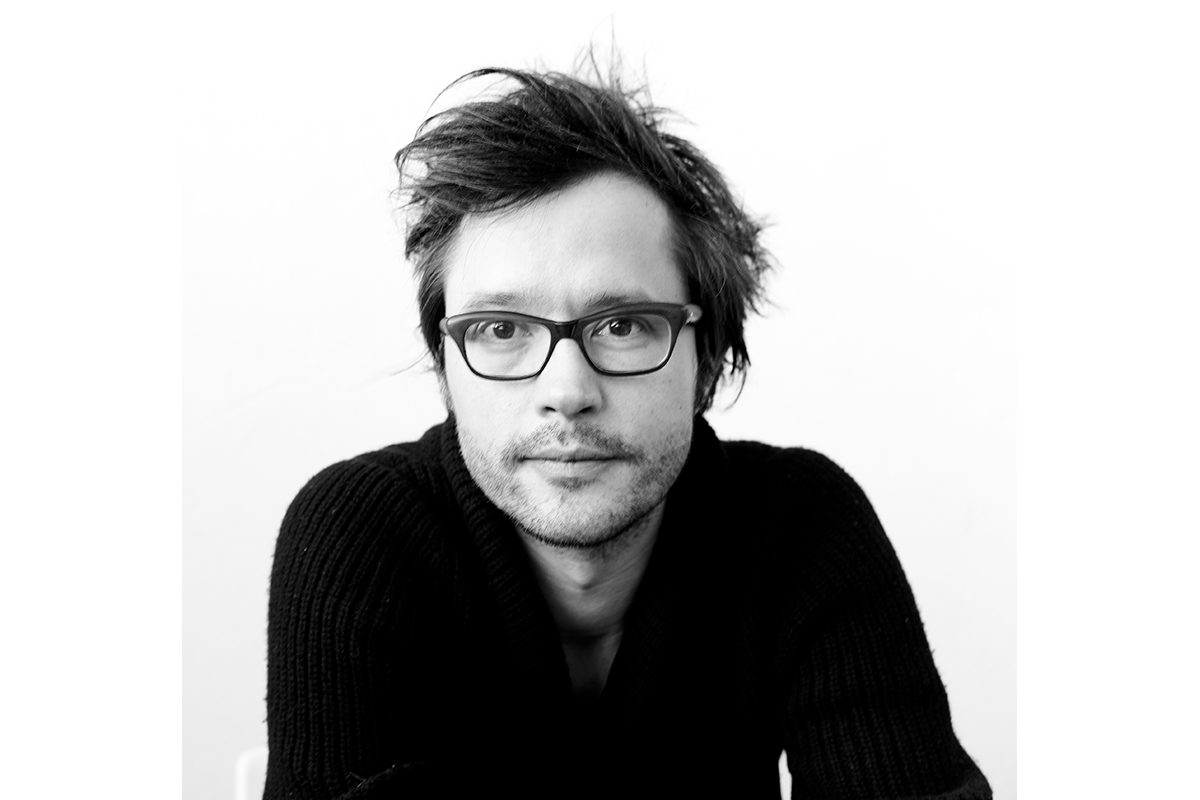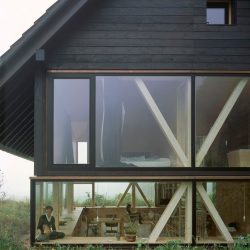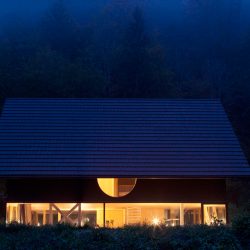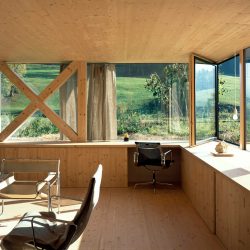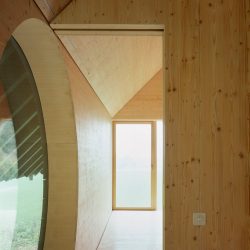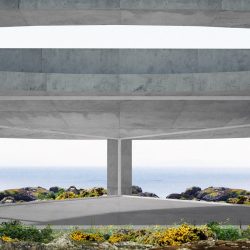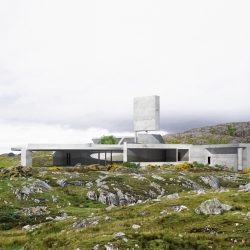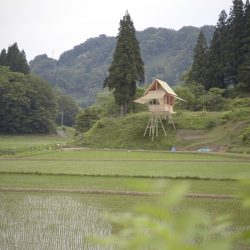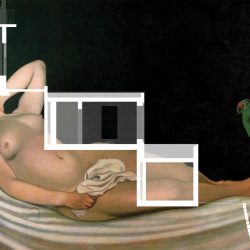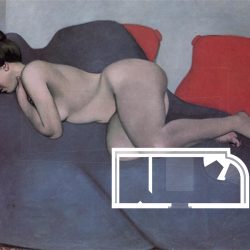PASCAL FLAMMER IS A SWISS ARCHITECT WHO IS DRIVEN BY THE SEARCH FOR SPECIFIC VALUES FOR CERTAIN CONDITIONS, SITUATIONS AND PROBLEMS THAT ARE RELATED TO HUMANS IN BOTH THE DIMENSIONS OF AN INDIVIDUAL’S EXISTENCE AND SOCIAL NORMS. BEFORE MAKING A NAME FOR HIMSELF THROUGH HIS OWN ARCHITECTURAL PRACTICE, FLAMMER WORKED AT THE OFFICE OF VALERIO OLGIATI, A RENOWNED SWISS ARCHITECT, BACK IN 1998. HE FOUNDED HIS OWN STUDIO IN 2005 FOLLOWING WHICH HIS WORKS BEGAN TO GAIN RECOGNITION AND WERE GRANTED MAJOR ARCHITECTURAL AWARDS INCLUDING THE SWISS ART AWARD IN 2006 AND THE PHILIPPE ROTTHIER EUROPEAN PRIZE FOR ARCHITECTURE IN 2014. APART FROM HIS PRACTICE, FLAMMER HAS BEEN INVITED TO TEACH AT A GREAT NUMBER OF LEADING INSTITUTIONS SUCH AS HARVARD UNIVERSITY, SANDBERG INSTITUUT, ETH ZÜRICH AND PRINCETON UNIVERSITY. WHEN IT COMES TO ARCHITECTURE, FLAMMER UNBINDS HIMSELF FROM ANY PARTICULAR DOGMA OR METHODOLOGY. HIS DESIGN PROCESS IS DRIVEN BY AN ATTEMPT TO CREATE A MOMENT OF CURIOSITY AS HE VIEWS THE MAKING OF ARCHITECTURE AS A PROPOSAL ALLOWING FOR HIM TO THINK THROUGH NEW TYPOLOGIES AND EVENTUALLY PRODUCE NEW POSSIBLE WAYS OF LIVING.
In some of your projects, the relationship between architecture and the landscape seems to be important, I’m not sure whether it is one of your main focuses, perhaps we can start with this topic?
Pascal Flammer: I think the topic of landscape is really important to me. Actually not so much in a very academic sense but quite strongly in a physical sense. I’m very interested to produce a combination of, kind of imagining how my life should be and how I could take place in that life. And they are actually, in a certain way, the culture… Let’s say that the physical reality of the surrounding is very crucial to me. Things like is it warm, cold, humid or sunny? Is it a mystical place? I think most of my buildings are not so much about the architecture itself in a certain way but very much about the question of how to place yourself into a surrounding or landscape. Principally, landscape can mean a green area or outside but it can also mean setting. I like to think of the surrounding as a physical reality. I’m very interested in physicality. But I also have a quite romantic relationship to green things, growing trees, plants, colors and also this idea of life. This undestroyable will to just live or grow. I think that it is for me a very principle fascination we see in nature. It’s this crazy, unstoppable power. I find also that nature has no moral. There’s no good and bad. No understanding and there’s no culture really. It’s more like a child. It just does in the most naïve but powerful way. And it’s only after a certain way, mankind tries to deal with this thing and we sometimes can, sometimes cannot.

The concept behind this timber house situated in Basthal, Switzerland, is to create a distinctive relationship between the landscape, ground floor and upper floor
So you are always trying to shape this relationship in a certain way?
PF: I feel like that’s the kind of principle things I do as an architect. I call what I do a proposal. I don’t make solutions. I also don’t make functional commitments. I try to propose a way of how we could also live in a certain way or with a certain purpose. How we could cohabit with nature or with others. So my work is never really a finalized piece and my work is not about being right or wrong, but in a certain way it’s a fantasy that I play in. But I’m also interested in reality. I see it as a surrounding, as this big playing field therefore I still call it a fantasy. It’s never a utopian. I’ve never been interested in thinking about how a building could fly. I actually look very much at what is our reality and I found that our reality is already crazily fascinating so I don’t see there’s a limitation at all.
But you also try to balance reality and fantasy, right?
PF: Yes of course. That’s why I came up with this idea of calling it a proposal. It was funny there was once a guy that I worked for, he was a client and he would say that at least you would have to be able to breathe in that house. It kind of means that within the boundary of physical abilities, but I like very much to take away moral or cultural expectations of limitations for a certain moment and I try to almost imagine only if, where, and how I could place my own body into what condition, in the term that I would find inspiring or interesting. I actually also start from a point of view that all human beings are similar. I test things on myself to see if it’s okay for me and then I can also propose them for others. I don’t try to understand the moral or society’s will and then try to somehow adapt it.
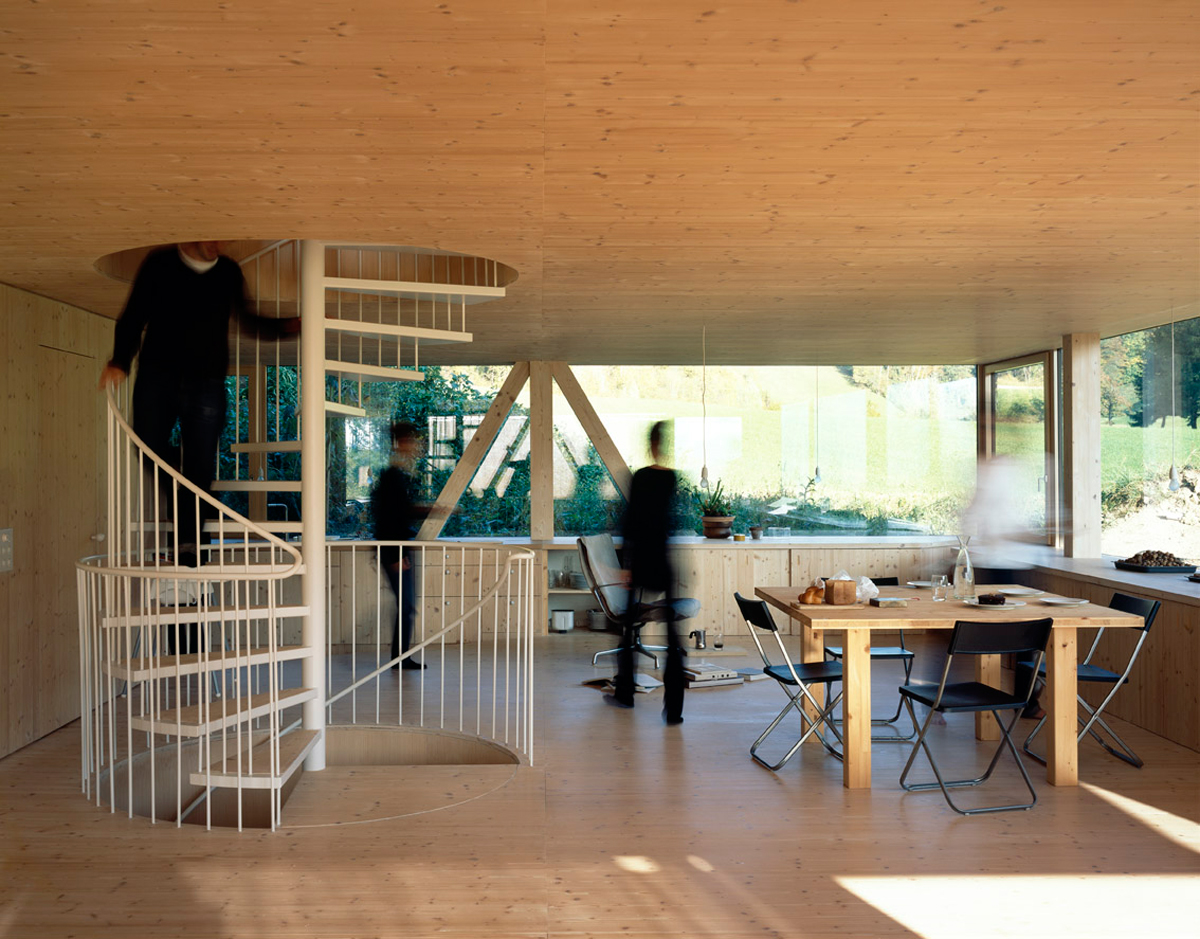
The horizontal windows are placed around the house to create a continuity with the surroundings

If we come back to the relationship between architecture and landscape, you give great importance to that relationship, but looking from the outside the architecture still has a dominant presence. It’s quite different from some contemporary projects where architecture is merged into or becomes the landscape.
PF: I think for example I’m not interested, at least not for the moment, in landscape as a construction – making shape, imitating shapes of nature. This, I’m not interested in. I actually quite like to keep thinking of dilemmas of the things that men make. I also like to play with nature with very basic and primitive rules. I find the idea to put a horizontal plate into a surrounding as a fundamental manipulation. I like that power and the contrast. Those buildings that I know that are very manmade and platonic in a certain way, very principle, simple geometry, in my way, they did not merge with nature.
I’m more interested to make its appearance, to give presences to the contrast or to the difference. Merging, unifying, oneness of the artificial and the natural, I would want to do the opposite. I would like to put a straight plate next to a plant, not another plant next to a plant.

A house situated on the seaside of the Isle of Skye in Scotland. The architect portrays that our lives are like strolling between curiosity and a defined condition
Allow me to ask about a set of your drawings, in which you place images of a nude woman behind architectural drawings. What kind of messages are you trying to communicate?
PF: Principally, what I do as an architect is to produce values, in which I want to put myself and people who experience my buildings into a state of curiosity. I find the moment of curiosity is the best condition I have experienced in my life. It’s the most productive, open, happy and joyful – connecting moment. I try to produce in myself and my surrounding the moment of curiosity. Since I’m an architect, I have to artificially produce that. It’s actually quite often that you have to produce a condition that you want to understand but not fully. However, it should be a condition that is not too complicated because then your head couldn’t trigger. We cannot hook up to it if it’s too complicated but if it’s too simple, we would be bored. I want to produce the moment of curiosity where we don’t really know what will come. It should be in the best way to open our head. I don’t know so much about Thai stories from old times, but there are a lot of Greek myths, little stories that you can understand in a simple way, the complexity, the contradiction that you don’t even know now how to solve it. But the contradictions are laid up in a principled way that one can think further about it. I develop different proposals and manners and techniques to bring people and myself into that state. And I do that, for example, with space. I produce space that people can read but also not. It’s also why I would never be interested to make organic architecture because I think it’s too clear.
But the lady in the image, it’s about the same topic. I was looking at this plan, because this is the house we’re building at the moment, with the picture behind. I personally like this plan. I may have to tell you this about my past. I used to do building that had inherited conflict and this building is one of the first buildings I started that is not so constructed. It’s more natural. I remember looking at this plan and cannot explain to people my personal tension I do have with the building because it does not have this set up or tension. I was just experimenting and I went ahead with this idea of putting the picture behind the plan as a way of trying to see if there is any emotion that can happen from this strange overlay of this very technical plan and the emotional image. It actually works really well. I try twenty different painters with different topics, like political, romantic, all kinds. I also think it marks a big change in my work because I started to compose later. It is just a proposal of bringing people into a certain state of curiosity and of course there are parts you understand and don’t understand and this sort of magic or power developing from this contrast.
Read more in art4d 257, March 2018

A set of architecture drawings of the small guest house in Bonassola Village, Italy in which the architect experimented with his idea to place paintings behind the structure
Pascal Flammer เป็นสถาปนิกรุ่นใหม่ชาวสวิสที่มีแนวคิดในการค้นหา “คุณค่า” (values) อันเฉพาะเจาะจงให้กับเงื่อนไข สถานการณ์ และปัญหาบางอย่างที่สัมพันธ์กับมนุษย์ ทั้งในมิติการดำรงอยู่ของปัจเจกบุคคลและวิถีของสังคม ก่อนที่ Flammer จะสร้างงานสถาปัตยกรรมภายใต้ชื่อของตัวเอง เขาได้ทำงานในสำนักงานของ Valerio Olgiati สถาปนิกชาวสวิสที่มีชื่อเสียงอีกคนหนึ่งตั้งแต่ปี 1998 หลังจากก่อตั้งสำนักงานของตัวเองในปี 2005 ผลงานของ Flammer ได้รับรางวัลสำคัญ เช่น Swiss Art Awards ในปี 2006 และ Philippe Rotthier European Prize for Architecture ในปี 2014 นอกจากการออกแบบแล้ว Flammer ยังได้รับเชิญให้สอนวิชาสถาปัตยกรรมในมหาวิทยาลัยชั้นนำหลายแห่ง เช่น Harvard University, Sandberg Instituut, ETH Zürich และ Princeton University ในการทำงานสถาปัตยกรรม Flammer ไม่ได้พยายามยึดติดกับแนวคิดหรือเทคนิคอันใดอันหนึ่งจนเป็นกฎเกณฑ์ที่ตายตัว ทั้งในกระบวนการออกแบบและงานสถาปัตยกรรมที่เกิดขึ้น เขามักจะสังเกตช่วงขณะแห่ง “ความใคร่รู้” (curiosity) ที่เกิดขึ้นในการทำงาน จากจุดนี้ที่ทำให้เขามองงานสถาปัตยกรรมในฐานะการสร้าง “ข้อเสนอ” (proposal) ที่จะตอบกับสถานการณ์ดังกล่าวได้ในทางใดทางหนึ่ง
ถ้าดูจากงานบางโปรเจ็คต์ของคุณ ความสัมพันธ์ระหว่างสถาปัตยกรรมกับภูมิทัศน์ดูจะเป็นเรื่องสำคัญ นั่นเป็นหนึ่งในเรื่องที่คุณให้ความสนใจรึเปล่า
Pascal Flammer: ผมคิดว่าภูมิทัศน์เป็นเรื่องที่สำคัญมาก นะ อาจจะไม่ได้สำคัญในแง่วิชาการแต่เป็นในเชิงกายภาพ ผมสนใจในเรื่องของการสร้างการผสมผสาน เหมือนกับการ จินตนาการว่าชีวิตของผมน่าจะเป็นยังไง และผมจะมีบทบาทยังไงในชีวิตแบบที่ว่า ในบางมุม วัฒนธรรม หรือจะเรียกว่าความเป็นจริงทางกายภาพของสิ่งที่แวดล้อมเราอยู่ ก็เป็นสิ่งที่มีความสำคัญกับผมด้วยเหมือนกัน เช่น ความ รู้สึกอุ่น หนาว ชื้น หรือแดดจ้า หรือความลึกลับของพื้นที่ใดพื้นที่หนึ่ง ผมว่าอาคารที่ผมออกแบบส่วนใหญ่ไม่ได้เป็นเรื่องของสถาปัตยกรรมมากเท่ากับการตั้งคำถามว่าเราจะเอาตัวเองไปอยู่ในสิ่งแวดล้อมหรือภูมิทัศน์หนึ่งๆ ได้ยังไงมากกว่า โดยส่วนใหญ่แล้ว ภูมิทัศน์สามารถหมายถึงพื้นที่สีเขียวหรือพื้นที่ภายนอก แต่ในขณะเดียวกันมันก็สามารถหมายถึงฉากหลังด้วย ผมชอบที่จะคิดถึงสิ่งที่แวดล้อมในฐานะของความเป็นจริงทางกายภาพ คือผมสนใจในความเป็นกายภาพของสิ่งต่างๆ แต่ผมก็มีความสัมพันธ์ที่เรียก ได้ว่าเป็นความคิดเชิงโรแมนติกกับสิ่งที่เป็นสีเขียว ต้นไม้ พืชพรรณ สีสัน รวมไปถึงสิ่งมีชีวิต ความมุ่งมั่นในการที่จะมีชีวิตอยู่หรือเติบโตโดยไม่มีอะไรจะมาทำลายล้างลงได้ สำหรับผมแล้วนี่คือความมหัศจรรย์ที่เราพบเห็นได้จากธรรมชาติ มันเป็นเหมือนพลังที่บ้าคลั่งและไม่มีอะไรมาหยุดได้ ผมยังพบว่าธรรมชาติปราศจากซึ่งศีลธรรมใดๆ มันไม่มีดีไม่มีเลว ไม่มีความเข้าใจ ไม่มีวัฒนธรรมก็ว่าได้ มันเหมือนเด็ก มันทำในสิ่งที่ไร้เดียงสาแต่ก็เต็มเปี่ยมไปด้วยพลัง และในบางครั้ง มนุษย์ก็พยายามจะรับมือกับอะไรบางสิ่งที่ บางทีเราก็รับมือได้บ้างไม่ได้บ้าง
หมายความว่าในทางหนึ่งคุณพยายามทำให้ความสัมพันธ์นี้เป็นรูปเป็นร่างขึ้น?
PF: ผมรู้สึกว่ามันเป็นเรื่องเชิงหลักการที่ผมต้องทำในฐานะของสถาปนิก ผมเรียกสิ่งที่ผมทำว่า proposal ผมไม่ได้ สร้างทางออก แล้วก็ไม่ได้ให้คำมั่นในแง่ของการใช้งานด้วย ผมพยายามนำเสนอวิธีการในการอยู่อาศัยในฐานะของรูปแบบหรือจุดมุ่งหมายอย่างใดอย่างหนึ่ง มันเกี่ยวกับว่าเราจะอยู่ร่วมกับธรรมชาติและสิ่งมีชีวิตต่างๆ ได้ยังไง ดังนั้นแล้ว งานของผมจึงไม่ได้เป็นงานที่เสร็จจบสมบูรณ์ แล้วก็ไม่ได้เป็นการบอกว่าอะไรผิดหรือถูกด้วย แต่เป็นเหมือนความฝันที่ผมเข้าไปเล่นกับมัน แต่ผมก็มีความสนใจในความเป็นจริง ผมมองว่ามันเป็นสิ่งแวดล้อมอย่างหนึ่ง เป็นสนามขนาดใหญ่ให้เราลงไปเล่น ซึ่งนั่นเป็นเหตุผลว่าทำไมผมถึงเรียกมันว่าความฝันหรือแฟนตาซี มันไม่ใช่สถานที่ในอุดมคติอะไร ไม่เคยเป็นแบบนั้นเลย ผมไม่เคยรู้สึกสนใจ ในการหาวิธีทำให้ตึกบินได้หรืออะไรแบบนั้นเลย ผมมองที่ว่าอะไรคือความจริงของเรา และผมก็ได้ค้นพบแล้วว่า ความเป็นจริงที่เราเผชิญเนี่ยมันทั้งบ้าบอและน่าทึ่ง เพราะฉะนั้น ผมจึงไม่ได้มองว่ามันเป็นข้อจำกัดอะไรเลย
แต่คุณก็พยายามหาสมดุลระหว่างความฝันกับความเป็นจริงอยู่
PF: แน่นอนครับ นั่นเป็นเหตุผลว่าทำไมผมถึงเรียกมันว่า proposal เรื่องตลกก็คือ มีลูกค้าที่ผมเคยทำงานด้วย แล้วเขาก็เคยบอกว่า อย่างน้อยที่สุดเขาก็ต้องสามารถที่จะหายใจในบ้านหลังนี้ได้นะ ซึ่งมันก็หมายความประมาณว่า ภายในขอบเขตของความสามารถทางกายภาพ ในชั่วขณะผมพยายามที่จะเอาความคาดหวังทางศีลธรรมหรือวัฒนธรรมที่มากับข้อจำกัดต่างๆ ออกไป และพยายามที่จะจินตนาการถึงการเอาตัวเองเข้าไปอยู่ในพื้นที่หนึ่งและสถานการณ์หรือสภาวะที่ผมคิดว่าจะช่วยสร้างแรงบันดาลใจหรือมีความน่าสนใจ ผมเริ่มจากมุมมองที่ว่ามนุษย์ทุกคนล้วนเหมือนกัน ผมทดลองสิ่งต่างๆ กับตัวเองเพื่อดูว่ามันโอเคกับตัวผมเองไหม ก่อนที่ผมจะนำเสนอมันกับคนอื่นผมไม่ได้พยายามจะทำความเข้าใจหรือปรับเปลี่ยนศีลธรรมหรือสิ่งที่สังคมตั้งเป้าไว้อะไรแบบนั้น
ถ้าเรากลับมาเรื่องของความสัมพันธ์ระหว่างสถาปัตยกรรมและภูมิทัศน์ คุณให้ความสำคัญกับความสัมพันธ์ที่ว่านี้มาก แต่มองจากภายนอก สถาปัตยกรรมของคุณก็ยังคงปรากฏตัวตนที่ค่อนข้างชัดเจน ซึ่งมันต่างจากงานร่วมสมัยบางชิ้นที่สถาปัตยกรรมถูกผนวกเข้ากับภูมิทัศน์หรือกลายเป็นภูมิทัศน์เสียเอง
PF: ผมคิดว่าถ้าให้ผมยกตัวอย่างนะ ผมไม่สนใจ อย่างน้อยก็ในตอนนี้นะ ในภูมิทัศน์ ในสถานะของสิ่งก่อสร้าง เช่นการ สร้างรูปทรง หรือเลียนแบบรูปทรงของธรรมชาติเหล่านี้ ไม่ได้เป็นสิ่งที่ผมสนใจ ผมชอบที่จะขบคิดถึงประเด็นปัญหาของสิ่งต่างๆ ที่มนุษย์สร้างขึ้น แล้วผมก็ชอบที่จะเล่นกับธรรมชาติด้วยกฎพื้นฐานในขั้นปฐมภูมิ เช่นการหาทางเอาวัตถุแนวนอนเข้าไปไว้ในสิ่งแวดล้อมหนึ่งและมองมันในฐานะของการเข้าไปจัดการหรือปรับเปลี่ยนอะไรที่มันเป็นพื้นฐานมากๆ ผมชอบพลังและความขัดแย้งแบบนั้น อาคารที่ผมเห็นว่าเป็นผลผลิตที่มนุษย์สร้างขึ้นแล้วมีความบริสุทธิ์ เป็นไปตามหลักการสร้างขึ้นจากรูปทรงเรขาคณิตพื้นฐานที่เรียบง่ายตามวิถีทางของผม มันไม่ได้ถูกสร้างเพื่อรวมเข้าเป็นส่วนหนึ่งกับธรรมชาติ ผมสนใจในการสร้างรูปลักษณ์ให้มัน ให้ความมีอยู่ของมันปรากฏอยู่อย่างแตกต่าง การเป็นส่วนหนึ่ง หรือการสอดประสานเป็นหนึ่งเดียวของสิ่งที่มนุษย์สร้างขึ้นกับธรรมชาติอะไรแบบนั้น ผมคิดว่าสิ่งที่ผมต้องการคืออะไรที่ตรงกันข้ามมากกว่า ผมอยากเอารูปทรงเส้นตรงไว้ข้างๆ ต้นไม้สักต้นมากกว่าจะเอาต้นไม้ไปไว้ข้างต้นไม้
ขออนุญาตถามเกี่ยวกับภาพวาดของผู้หญิงเปลือยที่คุณใส่ไว้ด้านหลังของภาพร่างสถาปัตยกรรม คุณพยายามจะส่งข้อความอะไรออกไปกับงานชิ้นนี้
PF: หลักๆ แล้ว สิ่งที่ผมทำในฐานะของสถาปนิก คือการสร้างคุณค่า ซึ่งผมอยากจะเอาตัวเองและคนที่ได้เข้าไปมีประสบการณ์กับอาคารที่ผมออกแบบไปอยู่ในภาวะของความสงสัยใคร่รู้ ผมพบว่าช่วงเวลาที่เรารู้สึกสงสัยในบางอย่างเป็น เวลาที่ดีที่สุดในชีวิตของผม มันเต็มไปด้วยความคิดถึงความเป็นไปได้ใหม่ๆ เป็นความรู้สึกเปิดรับ มีความสุข และสนุกสนาน เหมือนทุกอย่างถูกเชื่อมโยงเข้าด้วยกัน ผมพยายามที่จะสร้างภาวะแห่งความสงสัยใคร่รู้นี้ให้กับตัวเองและสิ่งแวดล้อมที่ผมอยู่ ด้วยความที่ผมเป็นสถาปนิก ผมก็ต้องสร้างมันขึ้นมาบ่อยครั้งนะที่คุณต้องสร้างสถานการณ์ที่คุณ รู้สึกว่าคุณเข้าใจมันแต่ไม่ทั้งหมด แต่มันก็ไม่ควรเป็นอะไรที่ซับซ้อนเกินไปเพราะไม่อย่างนั้นสมองคุณก็ไม่แล่น มันเหมือนกับเราต่อไม่ติดถ้าอะไรบางอย่างมันซับซ้อนเกินไป แต่ถ้ามันง่ายเกินไป มันก็ทำให้เราเบื่อได้อีกเหมือนกัน ผมอยากสร้างภาวะแห่งความสงสัยที่เราไม่รู้ว่าจะเกิดอะไรขึ้น นั่นน่าจะเป็นวิธีที่ดีที่สุดในการเปิดสมองของเรา ผมก็ไม่รู้ว่าประเทศไทยมีเรื่องเล่าจากอดีตอะไรแบบนั้นไหม แต่กรีกมีตำนานต่างๆ เรื่องเล่าสั้นๆ ที่คุณเข้าใจได้ไม่ยาก มันมีความซับซ้อน ความขัดแย้งที่คุณเองก็ไม่รู้ว่าจะแก้มันยังไง แต่มันก็เป็นความขัดแย้งที่ถูกนำมาวางเรียงกันอย่างมีหลักการ และมันก็ทำให้คุณสามารถคิดต่อไปได้ ผมพัฒนา proposal และวิธีการต่างๆ เทคนิคต่างๆ เพื่อนำผู้คนรวมถึงตัวผมเองเข้าไปอยู่ในภาวะนั้น เช่น ผมสร้างพื้นที่ที่คนสามารถเข้าใจแต่ในขณะเดียวกันก็ไม่เข้าใจ มันเป็นเหตุผลว่าทำไมผมจึงไม่มีวันที่จะสนใจสร้างสถาปัตยกรรมแบบ organic เพราะทุกอย่างมันชัดเจนเกินไป
แต่ผู้หญิงในภาพที่คุณว่า มันก็คือเรื่องเดียวกัน ตอนนั้นผมดูแปลนของบ้านที่เรากำลังสร้างกันอยู่ ซึ่งก็คืองานเดียวกับที่คุณถามนี่แหละ ส่วนตัวผมชอบแปลนนี้นะ แต่ผมต้องขอเล่าอะไรเกี่ยวกับตัวเองให้คุณฟังหน่อย ผมเคยต้องเข้าไปออกแบบอาคารที่มีประเด็นปัญหาเรื่องมรดกมาก่อน และอาคารนี้ก็เป็นหนึ่งในอาคารแรกๆ ที่ผมเริ่มทำแล้วมันก็ไม่ได้เป็นสิ่งก่อสร้างที่เป็นรูปเป็นร่างเท่าไหร่ แต่มันมีคุณสมบัติที่มีความเป็นธรรมชาติของมันอยู่ ผมจำได้ว่าดูแปลนโดยที่รู้สึกว่าตัวเองไม่สามารถจะอธิบายความตึงเครียดของตัวเองออกมา เพราะว่ามันไม่มีอะไรปูทางมาให้เลย ผมก็แค่ทดลองอะไรไปเรื่อยๆ ก่อนจะเดินหน้ากับความคิดที่จะเอารูปภาพมาไว้ข้างหลังแปลน เพราะอยากจะรู้ว่าการทับซ้อนแปลกๆ นี้จะสร้างอารมณ์แบบไหนออกมา แล้วแปลนนี้มันก็มีรายละเอียดเชิงเทคนิคอยู่เยอะเหมือนกัน ในขณะที่รูปมันก็มีอารมณ์ของมัน ซึ่งผลที่ออกมาคือมันไปด้วยกันได้ดี ผมลองใช้งานจากนักวาดภาพ 20 คน เปลี่ยนเนื้อหาของภาพไปเรื่อย ตั้งแต่การเมืองโรแมนติกทุกประเภทนั่นแหละ มันเป็นเหมือนการนำเสนอแนวคิดในการพาผู้คนเข้าไปอยู่ในภาวะของความสงสัยใคร่รู้ และแน่นอนว่ามันมีส่วนที่คุณเข้าใจและส่วนที่คุณไม่เข้าใจ มันเป็นความมหัศจรรย์หรือพลังในการพัฒนาอะไรบางอย่างขึ้นมาจากความแตกต่างขัดแย้งนี้
อ่านต่อใน art4d ฉบับ 257 มีนาคม 2561
INTERVIEWED BY WINYU ARDRUGSA
PHOTO COURTESY OF PASCAL FLAMMER ARCHITECT
pascalflammer.com

